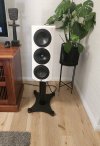Nice speakers.
And they publish data. So double-nice.
View attachment 345728
For sure the frequency response at the listening position will change due to the off-axis behavior. And the resulting ratio of direct and reflected sound. But if you just angle the speakers and don't move them, the bass won't change very much at all. Bass is omnidirectional, higher frequencies are directional.
For example, here is a speaker with fairly flat anechoic response in a bare room with nothing but concrete walls. The measurements are dominated by the response of the room which has large modes in this setup at 40 and 100Hz. The speaker is measured at the main listening position with both no toe-in, and toe-in of 10 degrees.
View attachment 345752
There is 1-2dB of treble attenuation, which is predicted from this speaker's spinorama data.

But the bass didn't change one bit.
To further illustrate, I rotated the speaker through 180 degrees being careful to not change the position relative to the wall. This is an obviously absurd experiment with the speaker pointed in all sorts of wrong directions, but I want to illustrate what actually affects bass, and what does not.
View attachment 345755
The 40Hz node and the response below 80Hz doesn't change! The 100Hz node does, change which doesn't surprise me since the speaker is close to the back wall in this measurement and even a small positional change relative to the wall will have an effect. SPL below 30Hz also changes just a bit. Next I will show this is all due to my inability to rotate the speaker precisely on it's acoustic axis!
Here are measurements of the same speaker in the same area of my room from the same MLP. but now facing out (no toe-in) at various distances from the center of the speaker to the back wall:
View attachment 345761
Here they are separated for clarity:
View attachment 345762
The 12" measurement, the speaker's port is about 7" from the back wall. Moving the speaker like this
does modulate the 100Hz null and the higher order nulls, which are caused by comb filtering as discussed
here:
View attachment 345759
This explains the change in the 100Hz.
How about the stuff below 30Hz? Some of that is the heavy equipment cleaning up the downed trees in our neighborhood affecting the measurement, I can see the subsonic energy in RTA. Also the room mode is sensitive to left-right positioning, and rotating the speaker isn't a perfect rotation since the speaker is finite size.
In summary, toeing in your Perlisten isn't changing the bass, unless you also moved it closer or further from the walls. Toe-in does affect the treble, which can/will alter your perception of the bass, but this is typically subtle and not really a likely explanation for why a speaker such as a S7t produces "very sloppy bass" with certain toe-in angles. If you changed the position of the speaker relative to the side or back walls, then that
will affect the bass. However, the most likely explanation is the most common one in audio, you expected a change and you heard one because of expectation bias.

